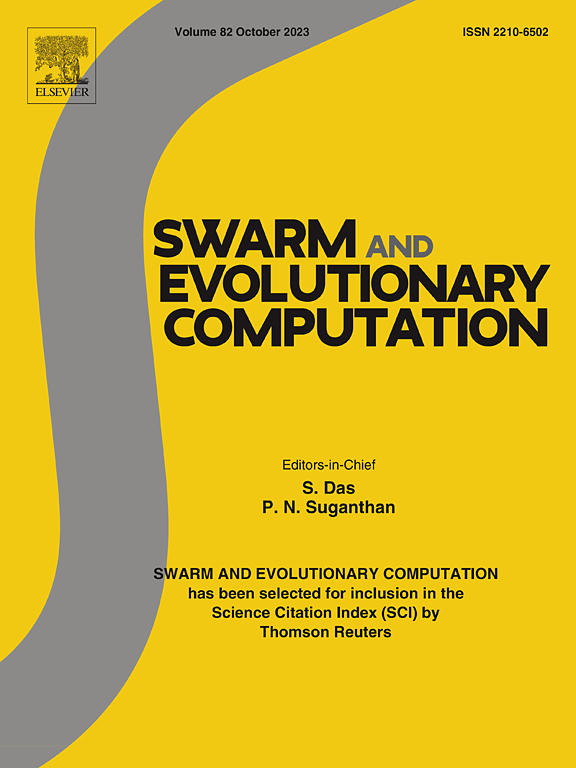Multiobjective multi-UAV path planning via evolutionary multitasking optimization with adaptive operator selection and knowledge fusion
IF 8.5
1区 计算机科学
Q1 COMPUTER SCIENCE, ARTIFICIAL INTELLIGENCE
引用次数: 0
Abstract
Path planning is crucial for UAV task execution, underpinning effective aerial reconnaissance and precision strikes. An ideal flight path must both minimize travel distance and reduce the risk of enemy detection or destruction. Due to the inherent trade-off between these objectives, multi-UAV path planning is conventionally formulated as a multiobjective optimization problem. However, as the number of obstacles, threats, and UAVs increases, the computational complexity escalates, hindering the generation of optimal path planning solutions via conventional multiobjective optimization approaches. To address this challenge, we model a multiobjective multi-UAV path planning (MOMUPP) problem that simultaneously optimizes flight distance and threat cost, with the latter quantified using line-of-sight theory and terrain occlusion effects. We further construct an auxiliary task that approximates the MOMUPP problem and develop an evolutionary multitasking framework to facilitate effective knowledge transfer between tasks. Building on this framework, we propose the evolutionary multitasking multiobjective path planning (EMMOP) algorithm. EMMOP incorporates a double deep Q-networks-based adaptive operator selection (DAOS) mechanism that dynamically selects the optimal search operators for each task based on the current evolutionary state, thereby generating high-quality offspring. Additionally, a knowledge transfer strategy based on directional information extraction and knowledge fusion (KTDF) enables efficient exchange of critical information between the main and auxiliary tasks. Experiments on 15 benchmark instances across five map scenarios indicate that EMMOP outperforms five state-of-the-art methods, enhancing hypervolume by 2.46% and pure diversity by 28.27%, while generating shorter, safer, and collision-free UAV paths with diverse trade-off solutions for decision-makers. The source code is available at https://github.com/Leopard125/EMMOP.
基于自适应算子选择和知识融合的多目标多无人机路径规划
路径规划是无人机任务执行的关键,是有效空中侦察和精确打击的基础。理想的飞行路线必须既能使飞行距离最小化,又能减少被敌人发现或摧毁的风险。由于这些目标之间的内在权衡,多无人机路径规划通常被表述为一个多目标优化问题。然而,随着障碍物、威胁和无人机数量的增加,计算复杂度不断上升,阻碍了通过传统的多目标优化方法生成最优路径规划解决方案。为了解决这一挑战,我们建立了一个多目标多无人机路径规划(MOMUPP)问题模型,该问题同时优化飞行距离和威胁成本,后者使用视距理论和地形遮挡效应进行量化。我们进一步构建了一个近似于MOMUPP问题的辅助任务,并开发了一个进化的多任务框架,以促进任务之间有效的知识转移。在此基础上,提出了进化多任务多目标路径规划(EMMOP)算法。EMMOP结合了一种基于双深度q网络的自适应算子选择(DAOS)机制,该机制基于当前进化状态动态选择每个任务的最优搜索算子,从而产生高质量的后代。此外,基于定向信息提取和知识融合(KTDF)的知识转移策略使关键信息在主辅任务之间有效交换。在5个地图场景的15个基准实例上进行的实验表明,EMMOP优于5种最先进的方法,将hypervolume提高了2.46%,将纯多样性提高了28.27%,同时为决策者生成了更短、更安全、无碰撞的无人机路径,并提供了多种权衡方案。源代码可从https://github.com/Leopard125/EMMOP获得。
本文章由计算机程序翻译,如有差异,请以英文原文为准。
求助全文
约1分钟内获得全文
求助全文
来源期刊

Swarm and Evolutionary Computation
COMPUTER SCIENCE, ARTIFICIAL INTELLIGENCEC-COMPUTER SCIENCE, THEORY & METHODS
CiteScore
16.00
自引率
12.00%
发文量
169
期刊介绍:
Swarm and Evolutionary Computation is a pioneering peer-reviewed journal focused on the latest research and advancements in nature-inspired intelligent computation using swarm and evolutionary algorithms. It covers theoretical, experimental, and practical aspects of these paradigms and their hybrids, promoting interdisciplinary research. The journal prioritizes the publication of high-quality, original articles that push the boundaries of evolutionary computation and swarm intelligence. Additionally, it welcomes survey papers on current topics and novel applications. Topics of interest include but are not limited to: Genetic Algorithms, and Genetic Programming, Evolution Strategies, and Evolutionary Programming, Differential Evolution, Artificial Immune Systems, Particle Swarms, Ant Colony, Bacterial Foraging, Artificial Bees, Fireflies Algorithm, Harmony Search, Artificial Life, Digital Organisms, Estimation of Distribution Algorithms, Stochastic Diffusion Search, Quantum Computing, Nano Computing, Membrane Computing, Human-centric Computing, Hybridization of Algorithms, Memetic Computing, Autonomic Computing, Self-organizing systems, Combinatorial, Discrete, Binary, Constrained, Multi-objective, Multi-modal, Dynamic, and Large-scale Optimization.
 求助内容:
求助内容: 应助结果提醒方式:
应助结果提醒方式:


